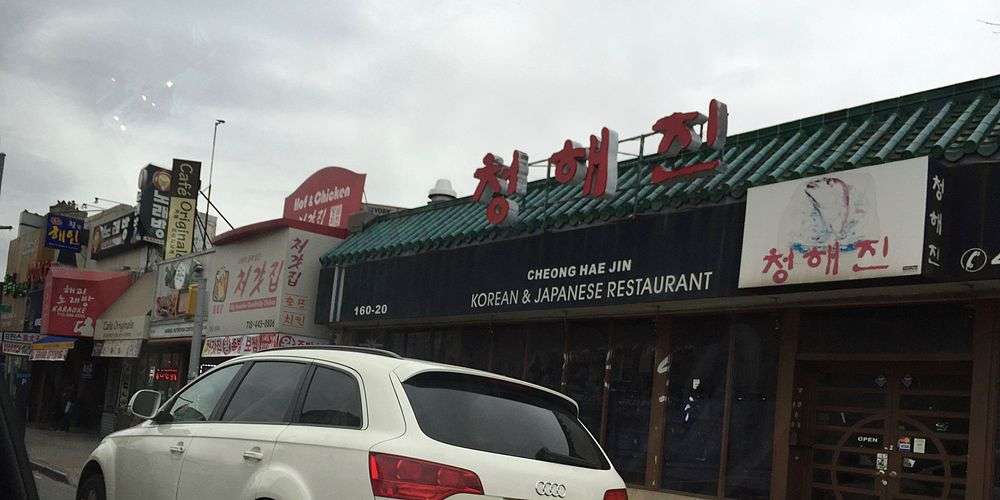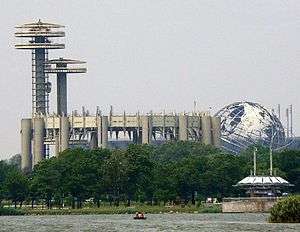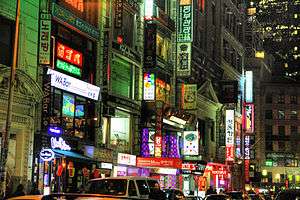Koreans in New York City
As of the 2011 American Community Survey, New York City is home to 100,000 ethnic Koreans, with two-thirds living in the borough of Queens.[6] On the other hand, the overall Greater New York Combined Statistical Area[7] enumerated 218,764 Korean American residents as of the 2010 United States Census, the second-largest population of Koreans outside of Korea and the most prominent.[8]
| Part of a series on |
| Ethnicity in New York City |
|---|
|
Ethnicities Arabs |
|
Neighborhoods Astoria Bed-Stuy Bensonhurst Borough Park Brighton Beach Chinatown, Brooklyn Chinatown, Flushing Chinatown, Manhattan Crown Heights Curry Hill Curry Row Elmhurst Flatbush Harlem Jackson Heights Jamaica Koreatown, Manhattan Koreatown, Queens Le Petit Senegal Little Australia Little Brazil Little Egypt Little Fuzhou Little Germany Little Italy Little Manila Little Poland Little Saigon Little Spain Little Sri Lanka Little Syria Little Ukraine Loisaida Spanish Harlem Sunset Park Thirteenth Avenue Washington Heights |
| Korean New Yorkers (뉴욕시의 한인) | |
|---|---|

40°44′32″N 73°52′43″W
History
Mass Korean immigration to the United States began in the 1950s, with a large wave occurring over the 1960s and 1970s. Koreans historically came to the New York City area with the intention of permanently settling in the metropolitan area and establishing businesses. Originally, ethnic Koreans settled in highly urbanized neighborhoods in Manhattan and Queens, but beginning in the 1980s, wealthier Koreans began moving to suburban communities in nearby Bergen County, New Jersey across the George Washington Bridge, alongside the Hudson River—as well as to adjacent Nassau County (on Long Island) and Westchester County, both locally within New York State itself. Many ethnic Koreans moved into areas already settled by the metropolitan Japanese community. By 1988, there were about 150,000 ethnic Koreans living in the New York City area.[9]
Geographic distribution
Manhattan's Koreatown (맨해튼 코리아타운) is primarily a Korean business district in Midtown Manhattan, but since 2008, the district has seen an increase in Korean and European traffic as well,[10] and the resident Korean population in the area has grown concomitantly. There was never a formal plan or agreement to create a Korean commercial district in Manhattan. However, given the high tourist traffic stemming from its proximity to the Empire State Building,[10] Macy's Herald Square, Penn Station,[10] Madison Square Garden, the Garment District, and the Flower District, amongst other Midtown Manhattan landmarks, it was an ideal location for Korean immigrants to settle. Initiated by the opening of a Korean bookstore and a handful of restaurants in the 1980s, Koreatown sprang into being. With their success, an additional stream of Korean-owned businesses took root in the neighborhood, coinciding with increased immigration from Korea; and with rising demand for the prime location, overall property values in the area increased as well.[10] According to the 2010 United States Census, the Korean population of Manhattan (co-extensive with New York County) had nearly doubled to approximately 20,000 over the decade since the 2000 Census.[11] Although Korea Way continues to represent the heart of Koreatown, situated between Broadway, Sixth Avenue, and Fifth Avenue, Koreatown itself has been expanding further eastward from Fifth Avenue along East 32nd Street, toward Madison Avenue in Midtown Manhattan, in the direction of Queens.[12][13][14] Koreatown, Manhattan has become described as the "Korean Times Square" and has emerged as the international economic outpost for the Korean chaebol.[15]
In the 1980s, a continuous stream of Korean immigrants also emerged into the Long Island Koreatown (롱 아일랜드 코리아타운), many of whom began as workers in the medical field or Korean international students who had moved to New York City to find or initiate professional or entrepreneurial positions.[1] They established a foothold on Union Street in the Flushing neighborhood of Queens, between 35th and 41st Avenues,[1] featuring restaurants and karaoke (noraebang) bars, grocery markets, education centers and bookstores, banking institutions, offices, consumer electronics vendors, apparel boutiques, and other commercial enterprises.[2] In 1990, Korean-American owned shops were boycotted in the Flatbush section of Brooklyn; the boycott started by Black Nationalist, Sonny Carson, lasted for six months and became known as the Flatbush boycott.
As the community grew in wealth and population and rose in socioeconomic status, Koreans expanded their presence eastward along Northern Boulevard, buying homes[5] in more affluent and less crowded Queens neighborhoods and more recently into adjacent suburban Nassau County, bringing their businesses with them, and thereby expanding the Koreatown itself.[2] This expansion has led to the creation of an American Meokjagolmok, or Korean Restaurant Street, around the Long Island Rail Road station in Murray Hill, Queens, exuding the ambience of Seoul itself.[2] The eastward pressure to expand was also created by the inability to move westward, inhibited by the formidable presence of the enormous Flushing Chinatown (法拉盛華埠) centered on Main Street.[1] Per the 2010 United States Census, the Korean population of Queens was 64,107,[16] while the Korean population of Nassau County had increased by nearly two-thirds to approximately 14,000 over one decade since the 2000 Census.[17] Korean Air and Asiana Airlines provide non-stop flights from Seoul to JFK Airport[18][19] in Queens, and the Consulate-General of South Korea in Manhattan has played an important role in mediating travel to and from Korea by the Korean diaspora living in the New York metropolitan area.

Other established and growing Koreatowns in the New York metropolitan area are located in nearby Bergen County, New Jersey, namely the Fort Lee Koreatown (포트 리 코리아타운) and the Palisades Park Koreatown (벼랑 공원 코리아타운). Signage in Hangul (한글) is ubiquitous in all of the Koreatowns.
Education
Korean language schools in the New York City region tend to have distinct educational missions and clienteles, and each school has its own distinct management. Because ethnic Koreans settling in New York City generally intend to permanently immigrate to the United States, the only Korean-oriented schools are supplementary institutions holding classes on Saturdays and Sundays.[20]
Korean churches typically hold Korean language classes for a half to one hour per week during Sundays. In addition to the churches, there are non-religious operators of Korean schools. In 1988, the Consulate-General of South Korea in New York stated that about 40% of the Korean schools in the New York City area were non-religious.[20] The first Korean schools were established by ethnic Korean churches.[21]
Individual Korean schools
The Korean School of New York was the first non-religious Korean school established in the city, opening in 1973. The founder, who remained as the school's principal academic administrator in 1988, believed that Korean language education should be separate from religion.[20] As of 1988, this school had 205 students.[22]
The Korean School of Queens originated as a church-operated school, and as of 1988, offered classes for elderly persons and children.[20] In that year, the school had 141 enrolled students.[22] As of 1988, the Korean School of New Jersey (뉴저지 한국학교) had 262 students,[22] making it the largest Korean school in the New York City area, serving students living in suburbs in northern New Jersey.[20] In 1988, the Church of Brooklyn Korean Language School had 120 students, the Broadway Korean School of New York had 97 students, the Westchester Korean School had 50 students, and the Pearl River Korean School had 36 students.[22] In 2014, the McGoldrick Branch of the Queens Library in Flushing began holding Korean language classes.[23]
Korean cuisine
Development of Koreatown, Manhattan as a Korean dining destination

Approximately fifteen restaurants conduct business 24/7 on Korea Way in Koreatown, Manhattan.[24] Korean restaurants in the district have had to expand or stay open around the clock to meet rising commercial rents and stay financially viable, given the growing prestige and high customer volume generated by foot traffic in Koreatown, Manhattan, and greater investment and involvement by the Korean chaebol.[15][25] Historically known as a more tourist-oriented alternative to the residential and somewhat suburban Flushing and Murray Hill, Queens in the nearby Long Island Koreatown, Koreatown in Manhattan has since developed a reputation as an authentic Korean dining destination.[25]
Recognition by chefs and authenticity of Korean cuisine in Queens
According to The New York Times, a "Kimchi Belt" stretches along Northern Boulevard and the Long Island Rail Road tracks, from Flushing, Queens, eastward into Nassau County, in the Long Island Koreatown. A prominent Korean food chef stated that "Queens is the closest you can come to authentic Korean food."[26] The Long Island Koreatown features numerous restaurants that serve both traditional and/or regional Korean cuisine. The development of this Koreatown has led to the creation of an American Meokjagolmok, or Korean Restaurant Street, around the Long Island Rail Road station in Murray Hill, Queens, exuding the ambience of Seoul itself.[2] Korean Chinese cuisine is also available in the Long Island Koreatown.[26]
Notable Korean New Yorkers and New Jerseyans
- Awkwafina – actress, rapper
- Richard Chai – fashion designer
- David Chang – international restaurateur
- Jun Choi – former mayor of Edison, New Jersey
- Kyung Hee Choi – Vice President, Asian Health Services and Korean Medical Program (한국인의 의료 프로그램), Holy Name Medical Center, Teaneck, Bergen County, New Jersey[27]
- Susan Choi – novelist
- Alton Chun – executive manager, five-star luxury Hotel Park Hyatt New York in Midtown Manhattan[28]
- Christopher Chung – the first elected mayor of Palisades Park, New Jersey, where Koreans constitute the majority of the population[29]
- Kyung Kim – chief operating officer, KFF Inc., parent company of Dons Bogam Korean barbeque restaurants in the New York metropolitan area[30][31]
- Ron Kim – member of the New York State Assembly, representing the 40th District, including Whitestone, Flushing, College Point, and Murray Hill in Queens
- Joo-Yung Lee – managing director, North American financial institutions, Fitch Ratings[32]
- Carol Lim – fashion designer
- Sandra Oh – actress
- Michael Yun – councilman, Jersey City, elected in 2013[33]
Media
Korean Americans have emerged prominently in the New York City journalism sphere. This media subsection has been created to acknowledge this prominence.
- Juju Chang – journalist, ABC News, anchor of Nightline
- Liz Cho – news anchor, WABC-TV
- Euny Hong – journalist, author of Birth of Korean Cool: How One Nation is Conquering the World Through Pop Culture (2014), which has been published in seven languages
- Jimmy Im – senior lifestyle writer, CNBC[34]
- Judy Joo – chef and television personality
- Allen Kim – digital producer, culture and trends, CNN[35]
- CeFaan Kim – journalist, WABC-TV[36]
- Eugene Kim – CNBC[37]
- Jasmine Kim – digital content journalist, CNBC[38]
- Michelle J. Kim – journalist and digital content producer, WNBC-TV[39]
- Tae Kim – investing journalist, CNBC[40]
- Yeji Jesse Lee – journalist, Business Insider[41]
- Karen Lee – weekend television anchor, News 12 New Jersey[42]
- MJ Lee – journalist, CNN[43]
- Jeenah Moon – photojournalist, The New York Times[44][45]
- Christina Park – journalist
- Hugh Son – journalist, CNBC[46]
- Elisa Ung – award-winning food writer and restaurant critic[47]
See also
- Koreatown, Fort Lee (포트 리 코리아타운)
- Koreatown, Palisades Park (팰리세이즈 파크 코리아타운)
- Asian Americans in New York City
- Bangladeshis in New York City
- Chinese people in New York City
- Demographics of New York City
- Filipinos in the New York metropolitan area
- Fuzhounese in New York City
- Indians in the New York City metropolitan region
- Japanese in New York City
- Russians in New York City
- Taiwanese people in New York City
Notes
- (in English) Kunieda, Mari (國枝 マリ; School of International Cultural Relations). "Assimilation to American Life vs.Maintenance of Mother Culture : Japanese and Korean Children in New York" (Archive; Japanese title: 異文化接触と母国文化 : 在ニューヨーク日本人・韓国人子女の場合). Hokkaido Tokai University Bulletin (北海道東海大学紀要): Humanities and social sciences (人文社会科学系) 1, 131-147, 1988. Hokkaido Tokai University. See profile at CiNii. Abstract in Japanese available.
- Min, Pyong Gap and Young I. Song. "Demographic Characteristics and Trends of Post-1965 Korean Immigrant Women and Men" (Chapter 5). In: Song, Young In and Ailee Moon (editors). Korean American Women: From Tradition to Modern Feminism. Greenwood Publishing Group, January 1, 1998. Start page 45. ISBN 0275959775, 9780275959777.
References
- Asian Americans: Contemporary Trends and Issues Second Edition, Edited by Pyong Gap Min. Pine Forge Press - An Imprint of Sage Publications, Inc. 2006. ISBN 9781412905565. Retrieved February 6, 2014.
- Kirk Semple (June 8, 2013). "City's Newest Immigrant Enclaves, From Little Guyana to Meokjagolmok". The New York Times. Retrieved February 6, 2014.
- John Roleke. "Flushing: Queens Neighborhood Profile". About.com. Retrieved February 6, 2014.
- "Koreatown Manhattan, or Koreatown Flushing?". CBS Interactive Inc. June 2009. Retrieved February 6, 2014.
- Joyce Cohen (March 23, 2003). "If You're Thinking of Living In/Murray Hill, Queens; The Name's the Same, the Pace is Slower". The New York Times. Retrieved February 6, 2014.
- "ACS DEMOGRAPHIC AND HOUSING ESTIMATES more information 2011 American Community Survey 1-Year Estimates, Geographies New York City, New York and Queens County, New York". Archived from the original on February 12, 2020. Retrieved February 6, 2014.
- "Profile of General Population and Housing Characteristics: 2010 Demographic Profile Data New York-Newark-Bridgeport, NY-NJ-CT-PA CSA". U.S. Census Bureau. Archived from the original on February 12, 2020. Retrieved February 6, 2014.
- Chi-Hoon Kim (2015). "Savoring Gotham: A Food Lover's Companion to New York City: A Food Lover's..." Oxford University Press, Google Books. Retrieved October 11, 2015.
- Kunieda, p. 133.
- Baldwin, Deborah (October 17, 2008). "Living In Koreatown Exotic Flavor, Beyond Just the Food". The New York Times. Retrieved February 6, 2014.
- "New York County, New York QuickLinks". U.S. Census Bureau. Archived from the original on June 19, 2013. Retrieved February 6, 2014.
- Gina Pace (April 26, 2015). "Koreatown in NYC is now being taken more seriously as a dining destination". New York Daily News. Retrieved March 6, 2018.
Koreatown — long centered on 32nd St. between Fifth and Sixth Aves., nicknamed Korea Way — has expanded in recent months. The new Baekjeong spot, for example, is located just east of Fifth Ave...Kihyun Lee took an even bigger gamble by opening a dual-concept spot midblock on 31st St. between Fifth and Madison Aves...
- Shinhan Bank America. Accessed March 6, 2018.
- Don's Bogam Korean restaurant. Accessed March 6, 2017.
- Sam Kim, photography by Gary He (July 31, 2018). "NYC's K-Town Isn't What It Used to Be". Vox Media. Retrieved November 22, 2018.
Most mom-and-pops are gone, and 32nd Street is now dominated by chains due to high rents and policies in Korea itself.
- "Queens County, New York QuickLinks". U.S. Census Bureau. Retrieved February 6, 2014.
- "Nassau County, New York QuickLinks". U.S. Census Bureau. Retrieved February 6, 2014.
- Matt Molnar (August 9, 2011). "New Korean Air Airbus A380 Makes First Flight to America". Copyright © 2012 NYCAviation All Rights Reserved. Retrieved February 6, 2014.
- "Flights from New York to Seoul". ©2011 Expedia, Inc. All rights reserved. Retrieved February 6, 2014.
- Kunieda, p. 137.
- Kunieda, p. 136-137.
- Kunieda, p. 147.
- "Queens library launches its first Korean language school" (Archive). Korea Times. October 10, 2014. Retrieved on April 10, 2015.
- Feldman, Zachary (2010-11-26). "In The Midnight Hour: BCD Tofu House in Koreatown". Retrieved February 27, 2018.
- Gina Pace (April 26, 2015). "Koreatown in NYC is now being taken more seriously as a dining destination". New York Daily News. Retrieved February 27, 2018.
Koreatown — long centered on 32nd St. between Fifth and Sixth Aves., nicknamed Korea Way — has expanded in recent months. The new Baekjeong spot, for example, is located just east of Fifth Ave...Kihyun Lee took an even bigger gamble by opening a dual-concept spot midblock on 31st St. between Fifth and Madison Aves...
- Pete Wells (December 16, 2014). "In Queens, Kimchi Is Just the Start - Pete Wells Explores Korean Restaurants in Queens". The New York Times. Retrieved February 27, 2018.
- "Korean Medical Program". Holy Name Medical Center, Teaneck, Bergen County, New Jersey. Retrieved July 26, 2018.
- Accessed July 31, 2018.
- Kristie Cattafi (January 3, 2019). "Palisades Park makes history in Bergen County, swears in first Korean-American mayor". NorthJersey.com - part of the USA TODAY network. Retrieved January 31, 2019.
- Accessed March 14, 2019.
- Accessed March 14, 2019.
- Accessed April 12, 2018.
- "WARD D (THE HEIGHTS) COUNCILMAN MICHAEL YUN". City of Jersey City. Retrieved June 28, 2018.
- Accessed September 28, 2018.
- Accessed May 11, 2020.
- "CEFAAN KIM". WABC-TV New York. Retrieved April 18, 2018.
- Accessed February 14, 2019.
- Accessed May 14, 2020.
- Accessed May 20, 2020.
- Accessed August 9, 2018.
- Accessed April 22, 2020.
- Accessed September 12, 2018.
- "CNN Profiles - MJ Lee - Correspondent". CNN. Retrieved April 5, 2019.
- Accessed March 11, 2019.
- Accessed March 11, 2019.
- Chris Roush (April 10, 2018). "Bloomberg's Son hired by CNBC to cover banks". Talking Biz News. Retrieved May 3, 2018.
- Accessed July 26, 2018.
Further reading
- Kim, Claire Jean. Bitter Fruit: The Politics of Black-Korean Conflict in New York City. Yale University Press, February 1, 2003. ISBN 0300093306, 9780300093308.
- Kim, Jongyun. Adjustment Problems Among Korean Elderly Immigrants in New York and Los Angeles and Effects of Resources on Psychological Distress and Status in the Family (dissertation). ProQuest, 2008. ISBN 0549566058, 9780549566052. UMI Number 3307607.
- Min, Pyong Gap. Ethnic Solidarity for Economic Survival: Korean Greengrocers in New York City. Russell Sage Foundation, April 3, 2008. ISBN 1610443985, 9781610443982.
External links
- (in Korean) The Korean School of New Jersey